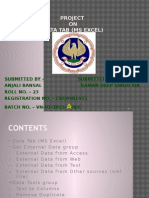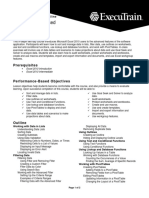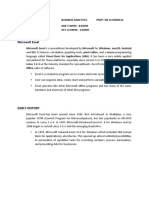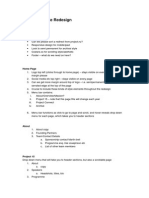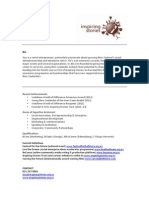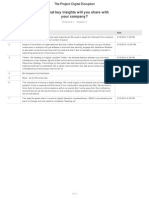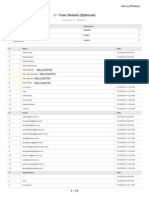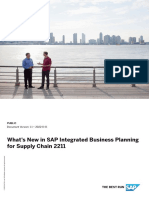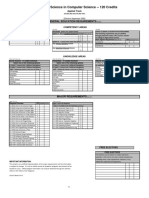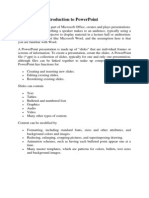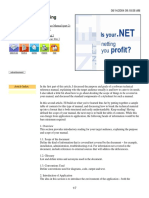Data Integration in
Excel
Dr. Nitin Paranjape
MVP (Office System)
Chairman and MD, Maestros
�Version information
Excel 2007 for all demos
Many features exist in 2003 as well
Keep Excel open to understand better
But, dont try to do what I am showing
Using Beta version
Complicated process of broadcasting voice
Please bear with any crashes,
disconnections
�Objectives
Understand available integration
options
Mapping business scenarios to
available features
Understanding strengths and
limitations of data handling
�POLL
How many of you have used Excel for
data handling in your applications?
�Data integration areas
Data capture within Excel
Getting external data into Excel
Accessing Excel data from outside
By Exporting it to another format
By keeping it within Excel
Processing data within Excel
Using Excel as a report writer
�Primary purpose of
spreadsheet is to analyze
data.
NOT to store data.
�Data sources
ODBC / OLEDB
SPS list
XML
OLAP
Text
Query files
�Import tools
Wizard (only ODBC)
MS Query (only ODBC)
Text import
Text import VBA code
Data connection wizard
�Query files and
connections
This facility has been available for
years
It works on ODBC sources only
Uses either a wizard or MS Query
Demo (Wizard and MS Query)
�Text Import
Highly complex text import possible
Fixed width or Delimited
Multiple delimiters supported
Decide data types while importing
Manage multiple delimiters
Manage preceding negative signs
Demo
�Text import
programmatically!
With ActiveSheet.QueryTables.Add(
Connection:="TEXT;C:\temp\test.txt"
,_
Destination:=Range("$A$1"))
.Name = "test"
.FieldNames = True
.RowNumbers = False
.FillAdjacentFormulas = False
.PreserveFormatting = True
.RefreshOnFileOpen = False
.RefreshStyle = xlInsertDeleteCells
.SavePassword = False
.SaveData = True
.AdjustColumnWidth = True
.RefreshPeriod = 0
.TextFilePromptOnRefresh = False
.TextFilePlatform = 437
.TextFileStartRow = 1
.TextFileParseType = xlDelimited
.TextFileTextQualifier =
xlTextQualifierDoubleQuote
.TextFileConsecutiveDelimiter
= False
.TextFileTabDelimiter = True
.TextFileSemicolonDelimiter =
False
.TextFileCommaDelimiter =
True
.TextFileSpaceDelimiter = False
.TextFileColumnDataTypes =
Array(1, 4, 3, 9, 1)
.TextFileTrailingMinusNumbers
= True
.Refresh
BackgroundQuery:=False
End With
�Importing ODBC vs
OLEDB
Import External Data = OLEDB
New database query = ODBC
Web query = import of HTML tables
from web sites
More options added in 2007
SQL Server direct
XML
Access
Analysis services
�Connections dialog in
Excel 2007
This is a major improvement
You can see all available Existing
connections in a single place
You can filter local, network and file
based connections in one dialog
This helps you reuse any past
connections quickly
Demo
�Deploying connections
across an organization
You can store Excel files in a special
library
Connection library in SharePoint
Users can point to a SPS site and ask for
connection information
This ELIMINATES the need to deploy /
send query files to multiple desktops
It also provides centralized access
control
�Capturing data within
Excel
Very commonly used by end users
Creates lots of problems
Accuracy, validation, structure is
missing
Users send files to each other
creating confusion and multiple
copies
�Native features of Excel for
capturing data
Linear data to auto-form : Demo
Validations : Demo
Forms & Control Toolbox controls
User based editing : Demo
(Ccard.xls)
�Understanding the
importance of Excel List
We work on blocks of data in Excel
When more data is added, formulas DO
NOT refresh automatically
This can lead to lot of errors
List corrects that problem
In addition, it integrates with SPS
In 2003, it is two way sync
In 2007, it is one way (from SPS to Excel)
Demo
�Capturing data in SPS
list
Better alternative
Keeps data central
Users can update individually
Shows only their own data
No Manual consolidation required
DEMO
�Exporting data
Supported formats
Delimited
XML spreadsheet
XML
Sounds like a limitation?
How do you pick up data from Excel and
put it directly into your database?
How do you use it with ETL tools like
DTS?
�Excel as ODBC source
Excel ODBC driver has been available
for years
Create a named range
Create ODBC source
The Excel file is considered the database
And Named ranges become tables
Now it can be used in any tool which
supports ODBC. Including Excel!
DEMO
�Report generation using
Excel
Connect to data source
Process the data
Analyze data
Render as report
Finally let user manipulate the read
only snapshot of report in Excel
�Report generation
options
Raw data with formulas and custom
formatting
You make the report yourself by adding data
from a recordset into Excel
Use SQL Reporting services to render it as
Excel
Pivot table : Demo
Create a base view of report
Let users do further analysis in a flexible way
�Eliminating the row limit
of Excel
The 65000+ limit of Excel is a misconception
There is no need to get data in Excel
Most want to do analysis using Pivot Table
Pivot table can be created DIRECTLY
In this case, there is no practical limit on
the number of rows
The Pivot Cache is available OFFLINE
automatically.
Pivot drag drop does NOT fire database queries
Only REFRESH button fires database level requery
�Pivot Table and
dashboards
Multiple copies of Pivot tables
showing different views of data
Multiple pivot tables from different
sources
Pivot Tables and Pivot Graphs
combined
�Importance of learning
Pivot Table
Extremely powerful
Eliminates complex SQL code
Users can change format anytime
eliminating further custom code
Data connection libraries + AD
security + pivot table is a very
secure, zero code solution for
reporting
�GetPivotData function
Initially it is confusing
For Pivot based calculations outside
the table
Very useful when you are managing
Pivot Tales programmatically
In this case you cant see the Row,
Column coordinates to put formulas
How to use it?: Demo
�OLAP reporting in Excel
2003 was primitive support
2007 provides better support
Many more cube functions added
The User interface is native and fast
Office web components are also
more responsive even if the data is
large
�Consolidation
Very powerful when data comes with
Row and Column headings (Cross tab
format)
Can be used programmatically
Saves lots and lots of coding
Results in Pivot Table: Demo
�XML
XML based, open, Excel file format
Server side data crunching without Excel
possible
For Excel functions, use Excel Services
Custom schema based editing,
validation and import export
Custom actions and element sensitive
Task Pane UI using .NET code attached
to XML schema (Smart Documents)
�Finally Excel Services based
reporting and data capture
Renders Excel data as pure web page in a
secure manner
Create Excel sheet. Name required ranges.
Post it in SPS library
Configure library to use Excel services
Now users can view Excel as a simple web
page
Interactivity is maintained
In-line editing is NOT possible
Specific, named cell values can be captured
Demo
�Usage scenarios
Interactive
Programmatic
�Interactive
Complex delimited text file imports
Consolidation
�Programmatic
1. Data capture forms / surveys
2. Reporting from OLTP / OLAP with end user level
report format editing capabilities
3. Dashboards
4. SQL reporting services render as Excel by default
5. SPS Lists based reporting
6. SPS List Business Data Catalog Excel reporting
7. Enterprise wide data connections in SPS lists
8. Office web component PivotTable to deliver
reports on Web
�Summary
Learn Excel first
There are many ways in which Excel can
be used for data capture, processing
and reporting
Map the application business needs to
the appropriate data handling method
This will make users happy and will
eliminate lots of complex code we write
everyday
�References
Old interface to new interface http://
go.microsoft.com/?linkid=5174798
Excel cell referencing (very useful while coding
in VBA)
http://www.expresscomputeronline.com/20021216/techsp
ace1.shtml
http://www.expresscomputeronline.com/20021223/techsp
ace1.shtml
Excel Help!
�Thank you
nitin@maestros.net
www.nitinparanjape.com/blog
Learn and Grow
�Quiz
This is not a POLL
You have to send your answers to
contact@erfolgcs.com
Format should be
1-A, 2-B and so on
�Question 1: What is the
number of rows available in
Excel 2007?
A. 65365
B. 1.5 million
C. 1.1 million
D. 1.04 million
�Question 2:
In Office 2007, the data How does
the data synchronization between
Excel 2007 Table and SPS 2007
A.
Changes
List
work? in SPS change data in Excel
table
B. Changes made in Excel change data
in SPS
C. Changes can be bi-directional
D. No changes possible. It is a snapshot
�Question 3:
Technology used to expose
business data in external
databases
in SharePoint 2007
A. Excel Services
is called
B. Business Data Catalog
C. Data Connection Library
D. None of the above
�Question 4:
Which type of data Excel
CAN
A. DBFNOT import?
B. SYLK
C. Visio
D. MDB


